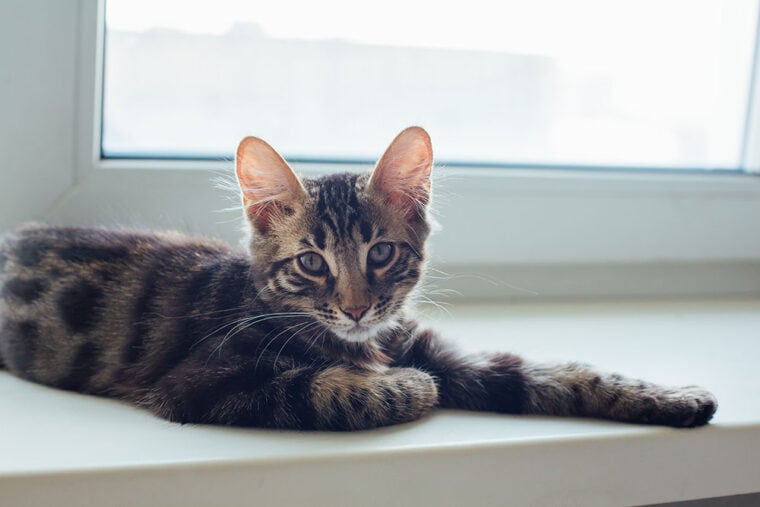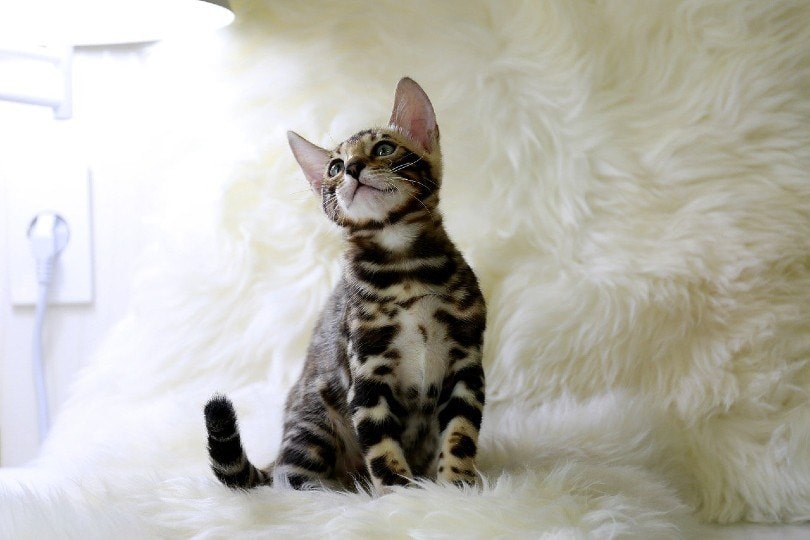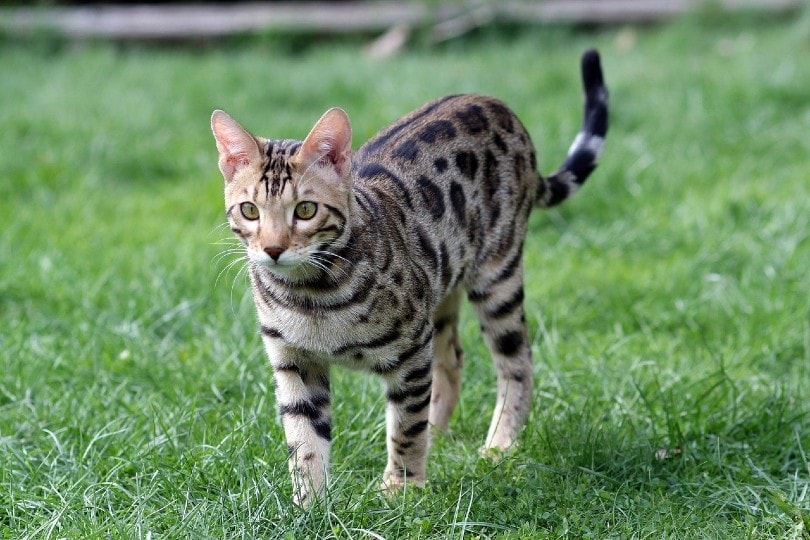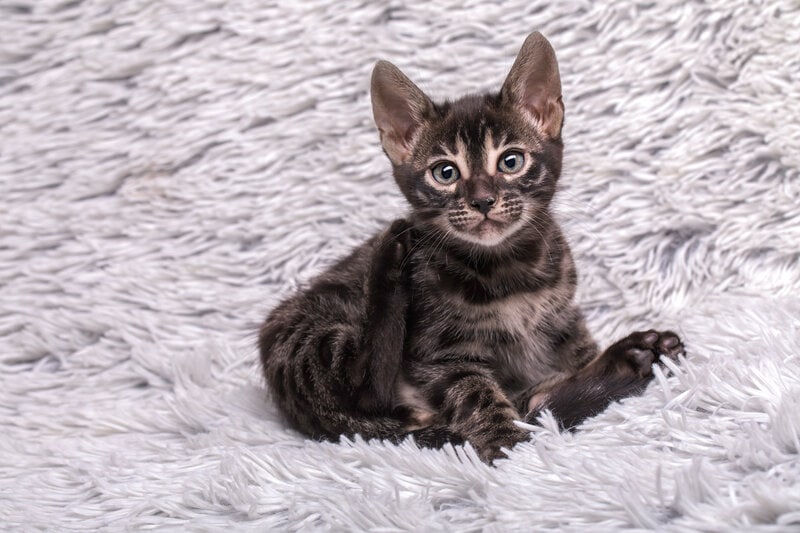
Click to Skip Ahead
The Bengal cat is a gorgeous, exotic-looking cat breed that gets its distinct look from its wild ancestors. A relatively new breed, they come in a variety of coat colors and patterns that have been obtained through selective breeding.
Breed Overview
Height:
13 – 16 inches
Weight:
8 – 17 lbs
Lifespan:
10 – 16 years
Colors:
Brown spotted, seal lynx point, sepia, silver, mink
Suitable for:
Experienced cat owners
Temperament:
Intelligent, energetic, playful
The charcoal Bengal cat features a unique and unusual dark, zorro-like face mask and some have a thick, dark dorsal cape. Charcoals have been around since the breed’s beginning but have only recently gained popularity.
Charcoal Bengals can either be spotted or marbled and come in all color categories within the breed including silver, brown, and snow.
Bengal Cat Characteristics
The Earliest Records of Bengal Cats in History
The Bengal cat is a hybrid between the domestic cat and the Asian Leopard Cat, which is a small species of wild cat that is widely distributed throughout Asia. These cats are similar in size to domesticated cats, reaching anywhere from 6 to 15 pounds and 18 inches in length.
The earliest record of this crossbreeding came nearly 100 years before these hybrids were ever considered their own breed. They were mentioned in Harrison Weir’s book titled “Our Cats and All About Them” which was published in 1889.
The modern-day Bengal cat got its beginning when Jean Mill obtained cats from Dr. Willard Centerwall, who was crossbreeding felines for research regarding immunity to feline leukemia. Jean Mill was a California native known for deliberately breeding the Asian Leopard Cat with a black domesticated cat.
Mill went on to develop the breed by adding other domestic cat breeds into her breeding program with the purpose was to offset wilder traits of the Asian Leopard cat.

How the Charcoal Bengal Cat Gained Popularity
The Bengal cat was more fully developed as a breed by the 1980s. They truly are the whole package and quickly became popular for both their looks and personality. Their popularity began to soar in the 2000s.
The standard coloration was the most sought-after look from the get-go. While charcoal Bengals are naturally occurring and have been around since the breed’s beginning, they weren’t as desirable until recently.
Breeders are now putting more focus on charcoal Bengal within their selective breeding programs. As with any more recently recognized cat breeds, the breed standard will continue to develop over time.
Formal Recognition of the Charcoal Bengal Cat
While the Bengal is a hybrid, it received formal recognition relatively quickly. Jean Mill’s breeding program took off during the 1970s and by 1986, the breed was officially accepted by The International Cat Association, also known as TICA. They eventually gained championship status in 1991.
The United Kingdom’s Governing Council of the Cat Fancy (GCCF) accepted Bengal cats in 1997 and the Fédération Internationale Féline and the Australian Cat Federation added them to their registries shortly afterward in 1999.
One of the last organizations to recognize Bengals was the Cat Fanciers’ Association or CFA. They didn’t fully recognize the breed until 2019 but once established, the Bengal quickly became ranked as one of the top 20 most popular cat breeds in the world.
Top 10 Unique Facts About Charcoal Bengal Cats
1. Bengals Love Water
Unlike most domestic cat breeds, Bengals genuinely enjoy swimming and will sometimes go out of their way to seek out water. This trait is passed down from their Asian Leopard Cat ancestors, as they are quite fond of the water themselves. From swimming pools to bathtubs, anyone that owns a Bengal should not be surprised if their cat were to jump right in.
2. Bengals Are Categorized by Generation
Bengals are established and categorized by filial generation. This is something that is also done in other hybrid cat breeds like the Savannah Cat and is used to determine how close generationally they are to their wild ancestors. Filial generation can play a role in the legalities of ownership and the ability to be formally recognized as a true Bengal.
3. They Enjoy Thievery
While it’s all in good fun, Bengals tend to steal random items and hide them throughout the house. These are usually shiny objects that they find a particular interest in like jewelry, keys, coins, and more. If something goes missing, you can expect it to turn up in an entirely random location eventually.

4. Bengals Typically Love Dogs
Another way this breed stands out from most typical domesticated cats is that they usually form close bonds with household dogs. Of course, this is dependent on whether the dog is a willing and friendly participant, but it is certainly one of the most unique and incredible Bengal qualities.
5. They Are Avid Hunters
This may come as no surprise, but these hybrids are excellent hunters. They have a particularly high prey drive and will enjoy hunting birds, rodents, and other small critters. This is something to keep in consideration regarding other household pets. A lot of caution should be exercised in households with pet birds, rodents, or any small pets that could easily be prey to a Bengal.
6. Bengals Do Great with Leash Training
Bengals have a few dog-like qualities overall and one of the most notable is that they are especially easy to leash train. This has a lot to do with their intelligence and sense of adventure. It’s good to start this at an early age but they tend to take better to harnesses than most other cats. Once leash trained, a Bengal is certain to enjoy going out on adventures with you.

7. They Are High Energy
A Bengal will never be placed in your typical lazy house cat category. This breed is incredibly active, energetic, and curious. Your entire home will be their playground, so expect them to find a way to access whatever they please. These cats are avid climbers and jumpers and will show off these skills regularly.
8. Bengals Love to Talk
This breed is very chatty and will have no trouble vocalizing their needs. From meowing, to growling, and chirps, you can expect a wide range of sounds to come out of a Bengal cat. Not only do they enjoy regular communication, but they also have an exceptionally loud purr.
9. They Are Glittery
Okay, so it’s not real glitter but the Bengal’s coat features a smooth, silky sheen that glimmers beautifully, especially under the light.

10. Bengals Aren’t for Everyone
Bengals aren’t your typical domesticated cat, so they aren’t going to be well-suited for all households. Their high energy and constant need for play and activity aren’t for everyone. They can get quite destructive if they become bored and they also have some territorial tendencies.
 Do Charcoal Bengal Cats Make Good Pets?
Do Charcoal Bengal Cats Make Good Pets?
Bengals are an agile and athletic cat breed that are very confident, friendly, and playful pets. They are always on alert and genuinely enjoy lots of activity. Their characteristics make them entertaining to be around.
When it comes to grooming, this breed is relatively low maintenance. They do shed regularly but excess hair can be controlled with regular brushing.
This breed is incredibly intelligent, so they do well with learning tricks and can train very easily. They must be physically and mentally stimulated or they can become destructive. This is a breed that will turn your home into its own personal playground. They thrive with a variety of toys, perches, and plenty of playtime with their people.
Bengals are social and tend to do well with children and other pets. A lot of their qualities are more like that of a dog. This is important to keep in mind if you’re interested in a Bengal cat because you will not be committing to your typical run-of-the-mill housecat.

Conclusion
Charcoal Bengal cats are a coat variation of the Bengal cat that features a dark, zorro mask and a thick, dark dorsal cape. Charcoal can be found in all color variations and is part of the breed standard. Charcoal has been around since the breed’s beginnings but has only recently begun growing in popularity. They have the same, wonderful characteristics as your standard Bengal cat with a more unique look.
Featured Image Credit: Smile19, Shutterstock







